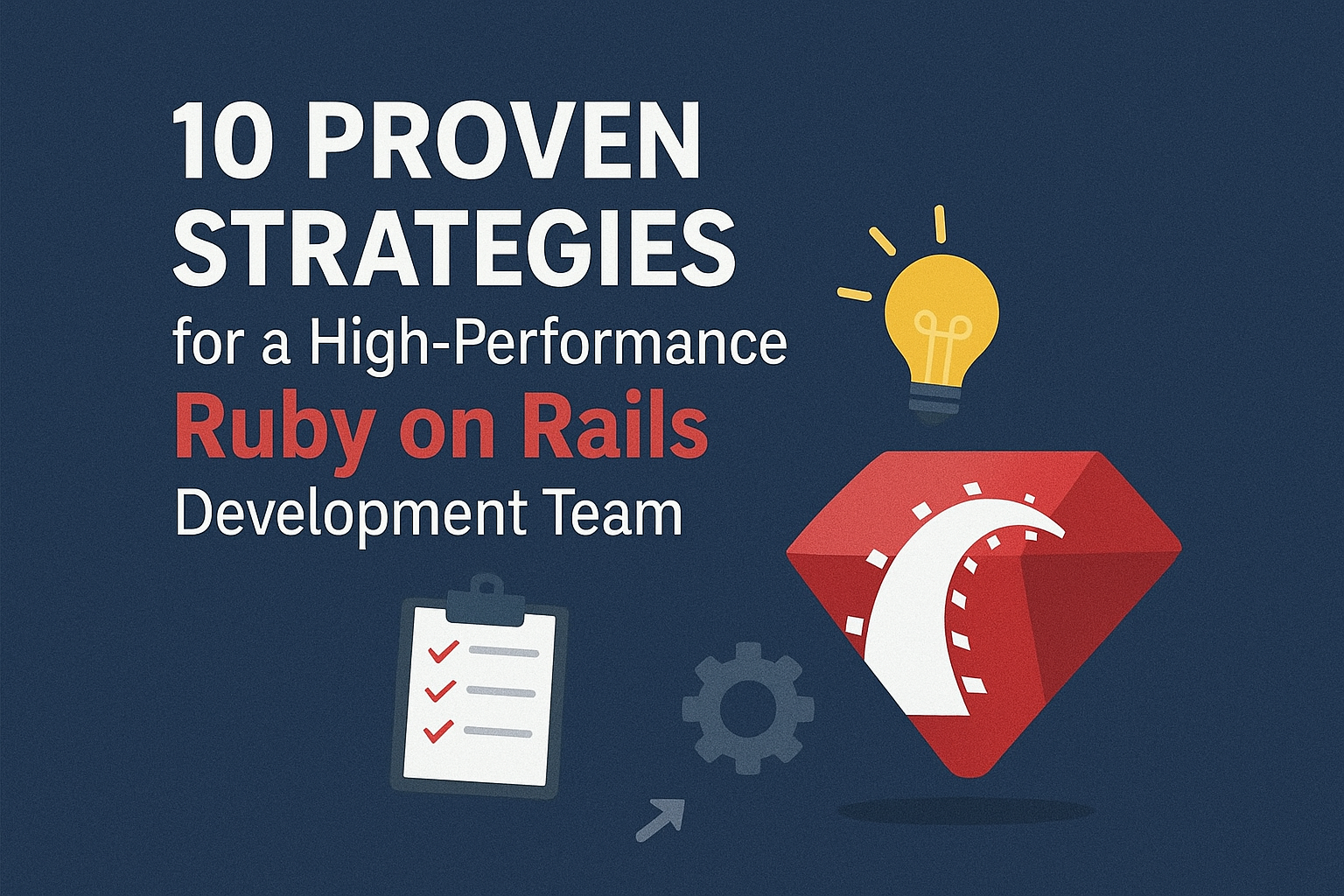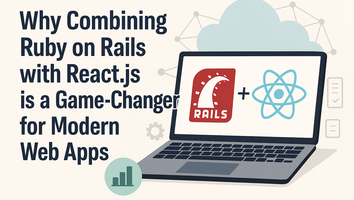For almost twenty years, Ruby on Rails has served as the backbone for web applications, supporting everything from innovative startups to large-scale enterprise platforms. While the framework’s conventions make development faster, building a high-performance Ruby on Rails development team requires much more than simply hiring people who can code in Ruby.
In this guide, we’ll explore 10 proven strategies to help you assemble, manage, and grow a team capable of consistently delivering results, whether you’re building in-house or leveraging Ruby on Rails consulting services.
- Begin with a Clear Discovery & Architectural Roadmap
Before any coding starts, the best consulting firms — like Thoughtbot and Bacancy — emphasize a discovery phase. This is where business goals are translated into technical blueprints.
How to do it right:
- Run collaborative workshops with stakeholders, product managers, and senior Rails engineers.
- Define project goals, MVP scope, performance targets, security requirements, and compliance needs.
- Create a visual architecture plan including:
- Application services and microservices
- Database design and indexing strategy
- APIs and integrations
- Scaling approach (cloud, load balancing, caching)
- Map out dependencies, risks, and fallback plans.
This ensures that every member of your Ruby on Rails development team works toward the same objectives from day one.
- Audit & Refactor Regularly to Maintain Peak Performance
A hallmark of elite Rails consulting services is continuous codebase health monitoring. Companies like Syndicode recommend frequent audits to identify technical debt before it impacts delivery.
Actionable steps:
- Schedule quarterly “technical health sprints” dedicated solely to code cleanup, performance optimization, and security patching.
- Implement automated code quality tools like RuboCop, Reek, and Brakeman.
- Use performance monitoring platforms like New Relic or Datadog to track slow queries, memory leaks, or scaling bottlenecks.
- Adopt a refactor-as-you-go approach — no new feature should be deployed without cleaning up affected areas.
This keeps your Rails app maintainable, scalable, and secure.
- Build a Diverse Skill Mix for Full-Stack Excellence
The most successful Ruby on Rails consulting companies assemble teams with a wide range of expertise — not just backend developers.
Roles to include:
- Ruby on Rails engineers (core backend logic)
- Front-end developers skilled in JavaScript, Hotwire, or React
- DevOps specialists for deployment automation, scaling, and CI/CD
- Database administrators for query optimization and indexing
- QA engineers for automated and manual testing
- UX/UI designers for user-centered product delivery
By mixing these skills, you eliminate bottlenecks and ensure that your Rails team can handle everything from server provisioning to pixel-perfect interfaces.
- Leverage Staff Augmentation & Fractional Consulting
Not every company can maintain a full bench of senior Rails developers year-round. Many Ruby on Rails consulting services offer staff augmentation or fractional consulting models.
Benefits:
- Access specialized expertise only when you need it.
- Bring in senior architects for critical phases (e.g., system migrations, performance audits).
- Maintain cost efficiency without sacrificing quality.
- Avoid long-term hiring commitments for short-term needs.
For example, you might bring in a fractional Rails consultant to design your API architecture, mentor your in-house team, and then transition out once the system is stable.
- Make Continuous Training Part of the Culture
Even seasoned Rails developers must keep pace with evolving best practices. The most respected Ruby on Rails consulting companies make professional development a core value.
Ideas to implement:
- Hold monthly internal workshops (“Rails Guilds”) to share new techniques, gems, or performance hacks.
- Encourage pair programming and rotating code review partners.
- Provide learning budgets for online courses, conferences, and certifications.
- Invite guest speakers from the Rails community for knowledge-sharing sessions.
A culture of continuous learning leads to improved code quality and quicker problem-solving.
- Establish Strong Communication & Feedback Loops
No matter how skilled your developers are, a high-performance team requires transparent and frequent communication.
Best practices:
- Use agile ceremonies (daily standups, sprint reviews, retrospectives) to keep everyone aligned.
- Document decisions in a shared, accessible format (e.g., Confluence, Notion, GitHub Wiki).
- Hold weekly “pulse meetings” where team members share progress, blockers, and suggestions for improvement.
- Foster psychological safety so developers feel comfortable flagging risks early.
The top Rails consulting companies excel at maintaining this kind of feedback culture, even in distributed teams.
- Implement Agile, Test-Driven, and CI/CD Practices
A common trait among elite Rails teams is the disciplined use of agile methodologies and automated testing.
Your Rails team should:
- Use Scrum or Kanban boards to visualize progress.
- Maintain a comprehensive test suite (RSpec, Capybara, Minitest) to catch regressions early.
- Enforce test-driven development (TDD) for critical modules.
- Set up continuous integration (CI) pipelines that automatically execute tests with every code commit.
- Automate deployments via CI/CD to ensure consistent, reliable releases.
This dramatically reduces downtime and improves overall product stability.
- Turn Senior Consultants into Mentors
One of the most underutilized benefits of Ruby on Rails consulting services is the opportunity for mentorship.
Instead of using senior consultants purely for firefighting:
- Have them lead technical retrospectives.
- Create onboarding documentation for new hires.
- Guide junior developers through challenging code reviews.
- Promote the adoption of best practices in architecture and testing through their example.
This approach not only improves your team’s current output but also builds future leaders.
- Use Transparent Contracts, Trials, and Metrics
Trust is critical when working with a Ruby on Rails consulting company. Clients and teams alike benefit from clear agreements.
How to build transparency:
- Provide short-duration trial projects before entering into long-term agreements.
- Clearly define deliverables, timelines, and escalation processes.
- Share metrics like velocity, defect rates, and deployment frequency with stakeholders.
- Tie compensation or bonuses to measurable outcomes.
This ensures alignment and minimizes surprises for all parties.
- Showcase Expertise to Attract & Retain Talent
High-performance Rails teams attract high-performance people. The best way to do this is by publicly demonstrating your expertise.
Ways to showcase:
- Contribute to open-source Rails projects.
- Publish case studies and technical blogs.
- Speak at RailsConf or regional meetups.
- Maintain an active GitHub organization.
- Share client testimonials and success metrics.
Leading consulting companies such as Thoughtbot and Planet Argon regularly share thought leadership content, which plays a key role in attracting top-tier Rails talent.
When you combine these 10 strategies, you get more than a group of coders — you build a Ruby on Rails development team that operates as a true business partner.
From the earliest architectural roadmap to the way you mentor junior developers, every decision should aim to improve performance, maintainability, and delivery speed. Whether you’re running your own Ruby on Rails consulting company or hiring one, these principles will help you achieve sustainable success.
A high-performance Ruby on Rails team isn’t built overnight. It’s the result of intentional hiring, continuous improvement, strong communication, and strategic use of consulting expertise.
If you’re ready to elevate your development capabilities, start by auditing your current team against these strategies. Identify the gaps, take targeted action, and consider partnering with a reputable Ruby on Rails consulting service to accelerate the transformation.
The frameworks, tools, and processes are available — it’s your team culture, leadership, and commitment to excellence that will turn them into a competitive advantage.



